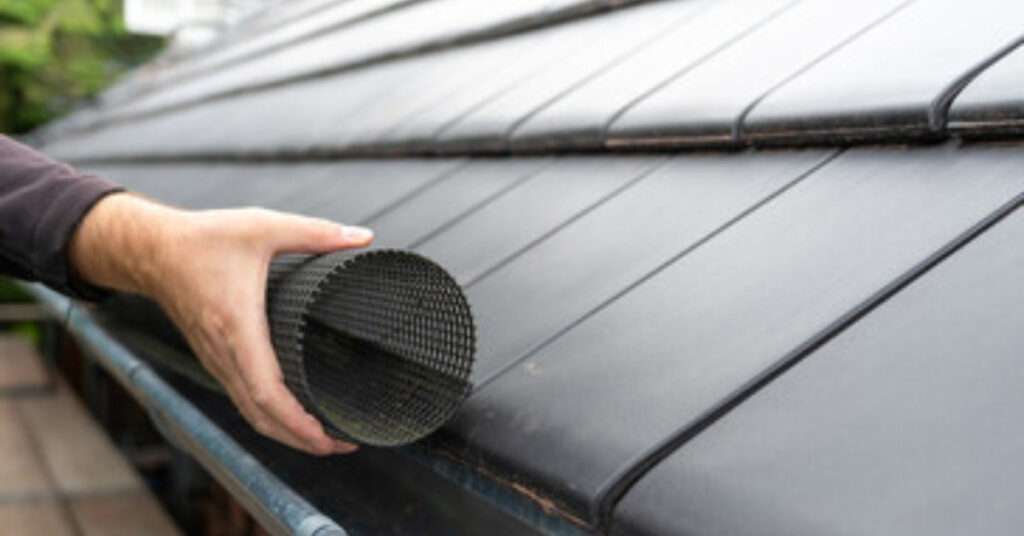Cleaning gutters can be a laborious and time-consuming task. However, with the advent of innovative gutter systems and accessories, homeowners now have the option to enjoy maintenance-free gutters. In this article, we will focus on leaf guards, a remarkable solution that eliminates the need for regular gutter cleaning. We’ll explore what leaf guards are, how they work, and the benefits they offer for keeping your gutters debris-free.
What are Leaf Guards? Leaf guards, also known as gutter guards or gutter covers. They are designed to prevent leaves, twigs, and other debris from clogging your gutters.
These devices are installed over or inside the gutters and act as a barrier. It allows only water to flow through while blocking solid materials.




Types of Leaf Guards:
1. Mesh or Micro-Mesh Screens:
Mesh screens are one of the most popular types of leaf guards. They consist of a fine mesh material covering the gutter’s top. This allows water to pass through while capturing leaves and larger debris.
Mesh screens are highly effective in preventing clogs and reducing the need for gutter cleaning. Regular maintenance involves removing accumulated debris from the mesh surface, which is much simpler than cleaning the entire gutter system.
2. Gutter Inserts:
Gutter inserts are another type of leaf guard that can significantly reduce gutter maintenance. These inserts are typically made of foam or brush-like materials that fit inside the gutter. They work by allowing water to flow through while trapping leaves and debris on the surface.
Gutter inserts are easy to install and remove, making cleaning a breeze. Remove the inserts, shake off the debris, and reinstall them for continuous protection.
3. Brush Guards:
Brush gutter guards, also known as bristle gutter guards, feature a flexible brush-like structure made of durable materials. They are inserted directly into the gutter channel to block debris while allowing water flow.
Their design comprises densely packed bristles attached to a central wire or spine. Brush gutter guards are relatively easy to install and provide a barrier against leaves and twigs. This reduces the risk of clogged gutters.
4. Foam:
Foam gutter guards are gutter protection systems. They use foam inserts, which are placed in the gutter channel. This allows water to flow through. The porous foam prevents larger debris from entering the gutters while maintaining efficient water drainage.
However, regular maintenance may be required to clean accumulated debris on the foam surface. They may be more suitable for areas with moderate debris accumulation rather than heavy foliage.
5. Reverse-Curve or Surface Tension:
Reverse-curve and surface tension gutter guards are two standard gutter protection systems. Reverse-curve guards use a curved design to guide water into the gutter while blocking debris.
While surface tension guards rely on water surface tension to channel water into the gutter through a small opening. The effectiveness of both types depends on factors such as roof slope, debris size, and guard design. Consulting with professionals can help determine the best option for your needs and local conditions.
6. Solid Covers:
Solid covers are leaf guards that completely cover the gutter, creating a solid surface that prevents debris from entering. These covers are designed to allow water to flow over the edge and into the gutter. At the same time, it keeps leaves and other debris out.
Solid covers offer excellent protection against clogs and are particularly effective in areas with heavy foliage. Regular maintenance typically involves clearing debris accumulating on top of the solid covers.
7. Hybrid Systems:
Hybrid leaf guard systems combine mesh screens and solid covers to provide comprehensive protection against debris. These systems often incorporate advanced designs that enhance water flow while keeping out leaves and other particles. Hybrid systems offer the advantage of reducing cleaning frequency even in challenging environments with high debris levels.



Benefits of Leaf Guards
The primary benefit of leaf guards is the significant reduction in gutter maintenance. By preventing debris from entering the gutters, they eliminate the need for frequent cleaning. This saves you time, effort, and potential accidents from climbing ladders.
2. Extended Gutter Lifespan:
Leaf guards protect your gutters from debris buildup, leading to corrosion, rusting, and structural damage over time. By keeping the gutters clean, leaf guards contribute to the longevity of your gutter system.
3. Prevention of Clogs and Water Damage:
Clogged gutters can cause water to overflow, leading to water damage on your roof, walls, and foundation. Leaf guards prevent clogs, ensuring that water flows freely through the gutter system, reducing the risk of water damage.
4. Pest Prevention:
Clogged gutters can become breeding grounds for insects, birds, and rodents. Leaf guards create a barrier that protects pests from your gutters, protecting your home from unwanted infestations.
Conclusion
Leaf guards are an excellent investment for homeowners looking to maintain clean and efficient gutters without the hassle of regular cleaning. With their ability to block leaves and debris while allowing water to flow freely, leaf guards significantly reduce maintenance. It also extends the lifespan of your gutters and prevents potential water damage. Consider installing leaf guards to enjoy hassle-free gutters and peace of mind with a well-maintained gutter system. Please call us if you have questions or want to schedule a free onsite estimate.
We look forward to meeting you.
“5 Reasons To Install Gutter Guards” By Emily Glover & Samantha Allan From Forbs
“Are Gutter Guards Worth It” By This Old House Team
